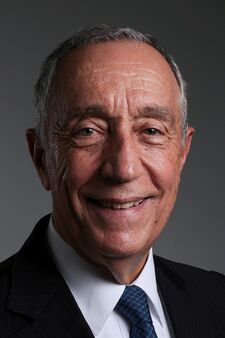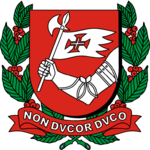President of Belmonte
| President of Belmonte | |
|---|---|
| Presidente de Belmonte (Iustan) | |
 Presidential flag of Belmonte | |
| Style | His/Her Excellency Mr/Mrs. President |
| Status | Chief of State |
| Member of | State Council National Defence Council |
| Residence | Mascarenhas Palace, Castelonovo |
| Nominator | Self-nomination |
| Appointer | Electoral College |
| Term length | five years, renewable |
| Constituting instrument | Constitution |
| Precursor | Captain-Regent |
| Formation | 18 April 1819 |
| First holder | Jorge Aranha |
| Salary | ₡68,837 |
The President of Belmonte (Iustan: Presidente de Belmonte), officially the President of the United Republic of Belmonte (Iustan: Presidente da República Unida de Belmonte), is the chief of state of Belmonte and therefore the highest officer in the country, as well as the commander-in-chief of the armed forces.
The origins of the presidential office could be traced back to the Federalist Revolt, where many members of the Belmontese elite of the time such as politicians, philosophers, merchants and military officers, unsatisfied with the current confederalist regime that they saw as weak and antiquated, started a revolt to establish a federalist republic with strong national institutions which received the support of a considerable majority of the population and the army, with the office being officially created in 1819. Initially, the president was both the chief of state and chief of government as well since Belmonte was a presidential republic, with the presidency slowly beginning to become an extremely authoritarian office thanks to its wide range of powers which made the National Congress left without any authority. Due to that, the Belmontese Revolution broke out in 1836, and a new constitution heavily limited its powers and established a parliamentary system of government. Since then, the president primarily serves as a figurehead without any practical or governmental power, although it still maintains some of them.
According to the 1836 constitution, it’s the responsibility of the president of command the armed forces; appoint and dismiss the prime minister and its cabinet; dissolve the parliament; convoke new elections; represent the State in international and domestic meetings; enact new legislation; order pardons; appoint ambassadors among others. The president is elected indirectly through the Electoral College, where it is needed at least half of the votes to be elected for a mandate of five years that could be renewable. As a way to maintain the office as much impartial as possible, it’s strictly prohibited that the president in office remains affiliated or shows support to any political party or association of its kind.
The president is also responsible for lead and manage the State Council of the Republic and the National Defence Council.
The current holder of the office is Caetano Villa-Lobos, who assumed the presidency at 15 of September of 2010.
Role
According to the constitution, the roles of the president of the republic are:
- Perform the office of commander-in-chief of the armed forces of Belmonte;
- Dissolve the National Congress as well as the government before convoking a new general election;
- Appoint the prime minister and its cabinet based on the results of the general election, with the power of dismissing them after the approval of a motion of non-confidence by the congress;
- Appoint senators after a general election under the consent of the prime minister and government and opposition parties;
- Proclaim a state of siege;
- Declare war or peace under the consent of the government and congress;
- Enact or veto any law or decree from the government and congress, with the veto being able to be overturned by the senate;
- Represent the country in international meetings and sign treaties;
- Appoint ambassadors under the consent of the government;
- Order pardons.
Selection
Eligibility
For someone become elected as president of the republic, the law requires that such person must be a born Belmontese citizen with its age being equal or above 35 years old. For its candidature become officialized, it’s necessary that a petition with at least 25 thousand signatures be submitted under the deadline of one month before the start of the election, and it must be properly validated by the supreme court.
Electoral process
After all candidacies are validated, the candidates will participate in several questionnaires and debates that are promoted by both public and private institutions over the month of July. These campaigns could receive private donations from political parties and other civic organizations, however, they are heavily fiscalized. The first turn of the election happens on the second Sunday of August, and if no candidate manages to get more than 50% of the votes of the electoral college, a second turn between the two most voted candidates happens on the penultimate Sunday of the same month.
Inauguration and oath
Soon after the election of the new president, the country enters into a transition period that lasts until September 15th, when, by tradition, occurs the inauguration of the new president of the republic in the national congress, where it’s declared its oath:
I promise, on my honour, defend Belmonte's sovereignty and freedom and comply with its Constitution.
After the oath, the new president goes to its official residence, the Mascarenhas Palace, where it happens the presidential sash change ceremony and meets with international representants and leaders. It’s a custom, although not an official one, that a prom happens at the night of inauguration day, being invited to such the members of the executive, legislative and judiciary powers as well as governors, ambassadors, diplomats and other relevant figures in general.

